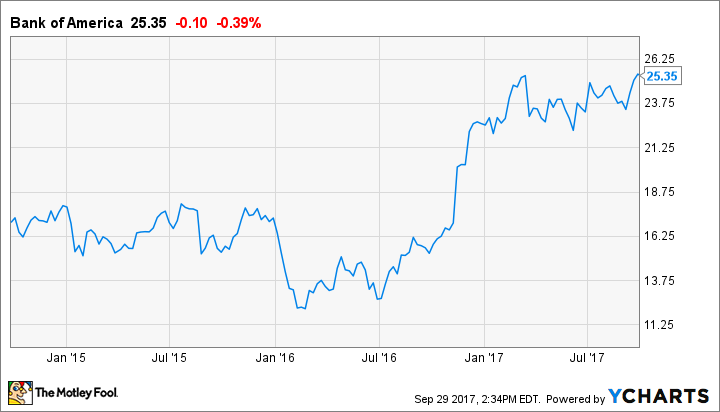It's almost hard to believe that Bank of America's (BAC 0.09%) stock could be closing in on $30 a share, but it is. The reason it's hard to believe this is because, at this time last year, it was trading for well below $20 a share. But then the election hit, and hopes began to rise that the regulatory relief and tax reform promised by then-candidate Donald Trump on the campaign trail would cause profits at banks to soar.
Little has happened on either of these fronts yet, but if there's progress, it isn't unreasonable to think that Bank of America's stock could indeed eclipse $30 a share in the not-too-distant future.

Image source: Bank of America.
Bank of America's valuation
There are two overarching reasons to think that this could come to fruition, the first of which is Bank of America's valuation. Shares of the Charlotte, North Carolina-based bank currently trade for just around 1.0 times book value, according to Yahoo! Finance. That makes Bank of America one of the cheapest big bank stocks on the KBW Bank Index, which tracks two dozen large-cap bank stocks.
The average valuation on the KBW Bank Index is 1.5 times book value. Consequently, given that Bank of America's book value per share is just under $25, all its shares would have to do to exceed the $30 threshold would be to trade at an average valuation.
If this were to happen, in fact, Bank of America could see its stock climb to nearly $40 a share.
Bank of America's profitability
Relatedly, the second reason why it isn't unreasonable to think that Bank of America's stock could cross the $30 barrier in the foreseeable future is that its profitability is improving. And when it comes to bank stocks, at least, the most important variable that plays into valuation is profitability.

Data source: YCharts.com. Chart by author.
The bank's return on average assets in the latest quarter was 0.93%. That's still below Bank of America's 1% target, which is also often considered to be the demarcation point between well-run banks and those that are struggling, but it's going in the right direction. In both the first quarter of this year, as well as the second quarter of last year, its return on assets was 0.88%.
Helping things along in this regard are the efforts that Bank of America has taken over the past few years to cut costs and improve efficiency. In the three months ended June 30, in fact, it was even able to get its efficiency ratio below 60%, meaning that it spends less than 60% of its net revenue on operating expenses. This progress not only put Bank of America where it wanted to be in terms of its efficiency target, it also came in below the notoriously efficient Wells Fargo in this regard.
As these efforts continue to bear fruit, Bank of America's bottom line will continue to benefit. And as its bottom line continues to benefit, so, too, should the valuation of its stock.







